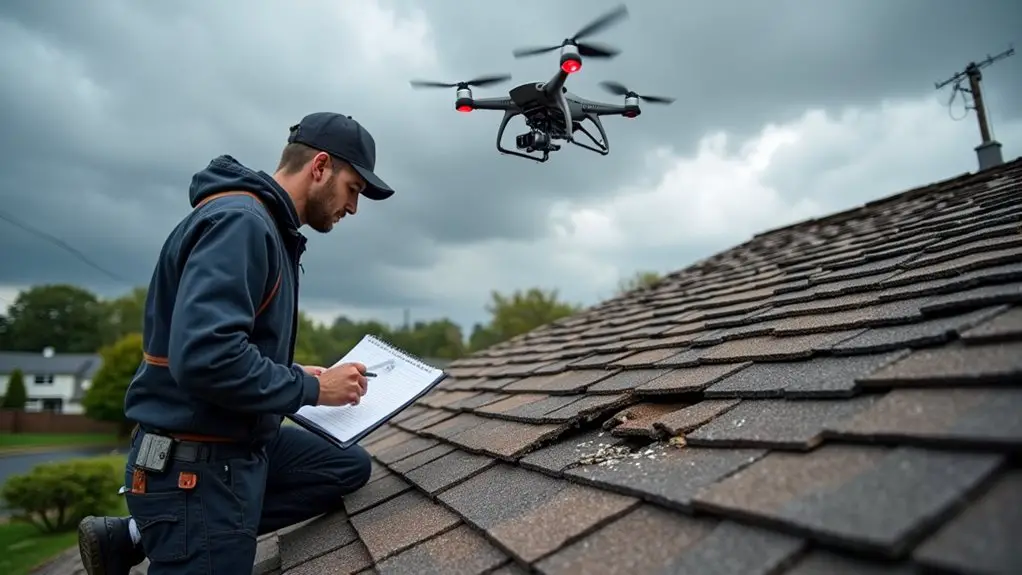10 Best Tips for Storm-Damaged Roof Evaluation

Your roof’s damage could lead to a waterfall in your living room if overlooked. Evaluating storm damage isn’t just about a quick glance; it requires a systematic approach. You need to know where to look and what to look for. From exterior checks to interior assessments, each step is vital in ensuring your home’s safety. So, how exactly do you navigate this potentially costly evaluation? Let’s explore the essential tips.
Conduct a Ground-Level Visual Inspection
When evaluating storm damage to your roof, start with a ground-level visual inspection, as it can reveal significant issues without needing to climb up. Look for missing, cracked, or displaced shingles. Notice sagging roof sections or uneven rooflines that might signal structural stress. Check for dents in metal components, like vents and chimney caps, which indicate impact damage. Also, keep an eye out for dark streaks on shingles, hinting at possible algae growth or water infiltration. If you see excessive granule accumulation in your yard, that’s a telltale sign of shingle damage. Conducting timely inspections can help you catch problems early, ensuring your home remains a safe haven for you and your loved ones.
Evaluate Gutter and Downspout Condition
Following your ground-level inspection, evaluating the condition of your gutters and downspouts is next. Start by checking for any dents, cracks, or bends caused by hail; these can seriously affect function. Make sure the gutters are properly aligned and securely attached—look for any sagging or separation. Inspect downspout joints for fractures that might block water flow. Remove any debris that could cause clogs, then test the water flow using a garden hose to catch slow-draining sections. Remember to check the seams for leaks and rust; these could lead to bigger issues down the line. Additionally, immediate contact with insurance after identifying damage is crucial for smooth claims processing. Document everything, including photos and measurements, as this information will be invaluable for insurance claims. Your home deserves the best care!
Assess the Interior Roof for Water Damage
To pinpoint water damage in your home’s interior, start by looking up at the ceilings and walls for any signs of trouble. Check for discoloration, bubbling, or peeling paint, and pay attention to watermarks and swelling in drywall. Sagging sections can indicate accumulated moisture, so be alert for that too. Don’t forget to inspect your attic; look at the joists and insulation for dampness or musty smells. If you notice any rust on metal surfaces, it’s a red flag. Document everything with photos and notes to track damage. Additionally, understanding damage classification can help you assess the severity of the water damage effectively. Also, consider neighboring areas for secondary damage. Address these issues promptly to guarantee your home stays safe and sound, creating a warm space where everyone feels secure.
Identify Roof-Type Specific Damages
Understanding the specific types of damage your roof may have suffered after a storm is essential for effective repairs and long-term maintenance. Start by evaluating your asphalt shingles for cracks, curling, or missing pieces; granule loss in gutters also signals potential issues. For wood shake roofs, look for splits or moss growth that could lead to rot. Tile roofs require an eye for broken tiles and any visible underlayment damage. If you have a metal roof, check for wavy panels or loose fasteners. Finally, slate roofs may show delamination or erosion around joints. By identifying these roof-type-specific damages, you’ll be better equipped to address repairs and protect your investment in your home. Utilizing an inspections checklist can further enhance your assessment process, ensuring nothing is overlooked during your evaluation.
Inspect Vents, Chimneys, and Skylights
After addressing roof-type-specific damages, it’s time to turn your attention to vents, chimneys, and skylights. Start by inspecting vent caps for detachment or corrosion, and check flanges for cracks or gaps to prevent leaks. Don’t forget to look for debris blockages that could affect airflow. For your chimney, examine the flashing for rust and verify mortar joints are secure against wind-driven rain. Finally, review skylights for seal integrity and any signs of water damage on nearby walls. Clear drainage channels to avoid pooling, and take the time to document everything for your records. These small steps can make a big difference, keeping your home safe and sound in your community. Remember to schedule timely inspections to prevent small issues from escalating into bigger problems.
Check for Missing or Cracked Shingles
Inspecting for missing or cracked shingles is essential for protecting your roof’s integrity. When you notice shingles missing, it leaves your roof vulnerable to water damage and structural issues. Cracked or curled shingles indicate wind damage and can greatly compromise your roof’s protective capabilities. Look out for signs of discoloration or bruising, as these suggest hail impact that weakens the surface. Uneven alignment might expose seams, increasing your risk of leaks during storms. Pay attention to debris accumulation near damaged shingles, which signals that localized repairs are needed. If you let these issues linger, you could face costly leaks, mold growth, and even diminished energy efficiency. Wind damage can exacerbate these risks, making it crucial to conduct timely inspections. Prioritize this inspection to keep your home safe and sound!
Look for Signs of Granule Loss
As storm damage can often hide significant roof issues, it’s crucial to watch for signs of granule loss. First, inspect your gutters and downspouts for granule accumulation; this can reveal deeper problems. Look for bald shingles where the asphalt is exposed, indicating granule displacement. Check for granules around splash blocks or pooled near downspouts. Compare the granule retention across various sections of your roof to spot any inconsistencies. Remember, while some granule loss is normal with age, a sudden spike after a storm indicates potential damage. Document your findings by taking pictures or making notes. This way, you can advocate effectively for your roof’s health, collaborating with professionals who share your concern for preservation and safety and ensuring that any issues are addressed before they escalate into more costly repairs.
Monitor for Debris Accumulation
While storms can leave your roof vulnerable, monitoring for debris accumulation is vital for maintaining its integrity. Start by evaluating your roof surface for foreign objects like tree limbs and loose branches that could cause damage. Look for any displaced shingles or punctures, as these may lead to leaks. Verify debris doesn’t exceed 10 pounds per square foot to prevent structural stress. Clear your gutters of leaves and granules to avoid overflow, and check downspouts for blockages. Inspect your property’s perimeter for patterns of wind-driven debris, as these can indicate the storm’s intensity. Additionally, ensure to be aware of significant wind which can blow shingles off the roof deck and worsen any existing issues. Don’t forget to document your findings with photos, as they’re valuable for insurance claims or contractor evaluations. Together, we can keep our roofs safe and secure.
Review Attic Conditions and Insulation
After clearing debris, it’s time to evaluate your attic conditions and insulation. Start by inspecting for water leaks and moisture. Look for water stains, soft spots, or any discoloration, as these can indicate roof issues. Don’t ignore any mildew odors, which suggest prolonged moisture exposure. Next, check your insulation’s integrity. If it’s wet or compressed, replace it immediately to prevent mold and energy loss. Verify there are no gaps, especially near eaves and vents. Also, assess your ventilation systems; clear obstructions and check for rust or damage. If you spot any structural issues, it’s best to consult a professional. Roofs are most vulnerable during severe storms, making this evaluation crucial. Keeping your attic in good shape not only protects your home but also fosters a sense of security for your family.
Document Findings for Insurance Claims
Documenting your storm damage promptly is crucial for a successful insurance claim. Start by capturing timestamped photos and videos of the damaged areas, including both wide-angle shots and close-ups. Make sure to document missing shingles, leaks, and any water pooling. It’s important to take detailed notes explaining the damage’s cause and severity. Additionally, filing claims is essential for repair or replacement compensation, as it initiates the process with your insurance company.
Hire licensed contractors for professional assessments, and obtain written reports that outline necessary repairs and costs. Remember to document any temporary fixes you implement, along with their receipts. Collect storm data, like hail size and wind speed, to support your claim. Organize everything in a digital folder, labeling photos and maintaining a clear timeline. This thorough approach strengthens your claim and enhances your community bond.
